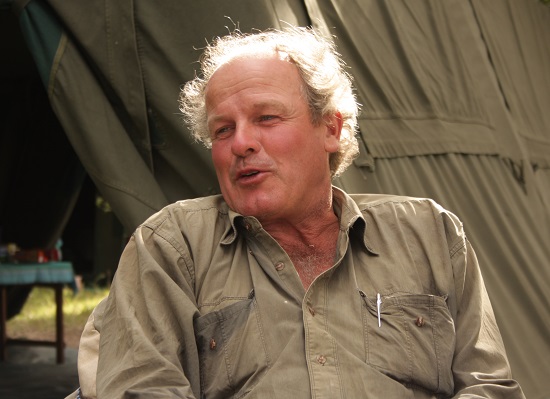 Tristan Voorspuy could identify every tree, every bird, and every creature that walked the landscape, and was a force for preservation. / Garth Thompson photo
Tristan Voorspuy could identify every tree, every bird, and every creature that walked the landscape, and was a force for preservation. / Garth Thompson photo
Tristan Voorspuy, sixty, was ambushed and murdered on his Sosian ranch on March 4, 2017. We report this breaking news because Tristan was well-known and respected by so many foxhunters across North America who traveled to Kenya for his riding safaris.
Tristan led most of the safaris. He could identify every tree, every bird, and every creature that walked the landscape, and had stories to tell about each. His death at the hands of renegade tribal warriors comes as a painful shock to those who remember him as a gifted horseman, pilot, former foxhunter, bold and rugged friend, naturalist, and a force for conservation in Africa. He truly cared about and and worked for the preservation of his natural world.
In fact, in a bizarre way, Tristan’s murder can be directly related to his conservation success. In 2005, Tristan and six investors purchased Sosian, a 24,000-acre ranch that was badly degraded. Tristan turned it into a highly successful wildlife conservation project, one of a number of large ranches that double as wildlife conservancies. Tribal warriors, members of Kenya’s Samburu and Pokot ethnic groups who live in an area denuded by drought and livestock, have recently seized several of these ranches so they may now graze their goats and cows.
The invaders had burned several buildings on Sosian, and Tristan rode out to check on damage to the only building that had not been burned. He was ambushed and shot to death. As the first white farmer to be killed since the invasions began last year, the act represents a major escalation in an offensive that many white farmers believe to be a politically motivated land grab in one of the country’s most important conservation areas.
When Tristan failed to return, a neighbor flew over the area and spotted his badly injured horse. A tracker later found and identified his body, which as of March 5th had yet to be retrieved. Though large gangs of armed warriors still patrol the area, it has since been recovered.
Drought-related invasions in the area are not uncommon, but few have been so violent. According to Adrian Blomfield’s account in The Telegraph, “as many as twenty black Kenyans have been killed, among them workers on white-owned farms. Some white ranchers have also been shot at and one black rancher was shot and wounded last year.” Wildlife, including elephants, have also been killed, allegedly by poachers, on area ranches that have fallen to the invaders.
Tristan was born in South Africa, went to secondary school and college in the UK, served in the British army for six years in the 1970s, and was a member of the Household Guards for two years. After leaving the army, he drove a motorbike from London to Cape Town, looking for work in Africa. He created Offbeat Safaris in 1990.
In Kenya, for a time, he maintained a pack of foxhounds for hunting. He lived near Nairobi at Deloraine, a historic colonial farm estate built by Lord Francis Scott, uncle of Princess Alice, Duchess of Gloucester. Deloraine has played host to many notables, including both the Queen Mother and the Duchess of York in its time. Tristan is described in The Telegraph article as “a central figure in white Kenyan society.”
Following Tristan across the Mara in the hoofprints of the English explorers of another century, and experiencing, only as one can on horseback, those vast plains sustaining multitudes of wildlife in the manner in which those explorers had first witnessed it, was surely one of the great adventures of my life. Tristan Voorspuy will never be forgotten by any of us who followed, marveled, and learned from him on safari.
Posted March 6, 2017
 Historic Deloraine, host to the Queen Mother and the Duchess of York in its time, was Tristan’s home. / Garth Thompson photo
Historic Deloraine, host to the Queen Mother and the Duchess of York in its time, was Tristan’s home. / Garth Thompson photo

















